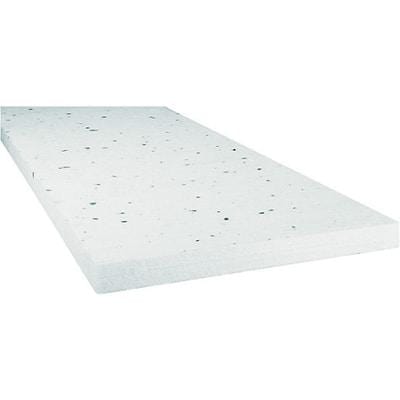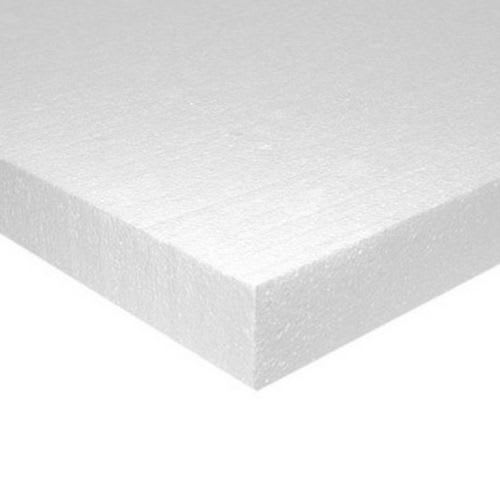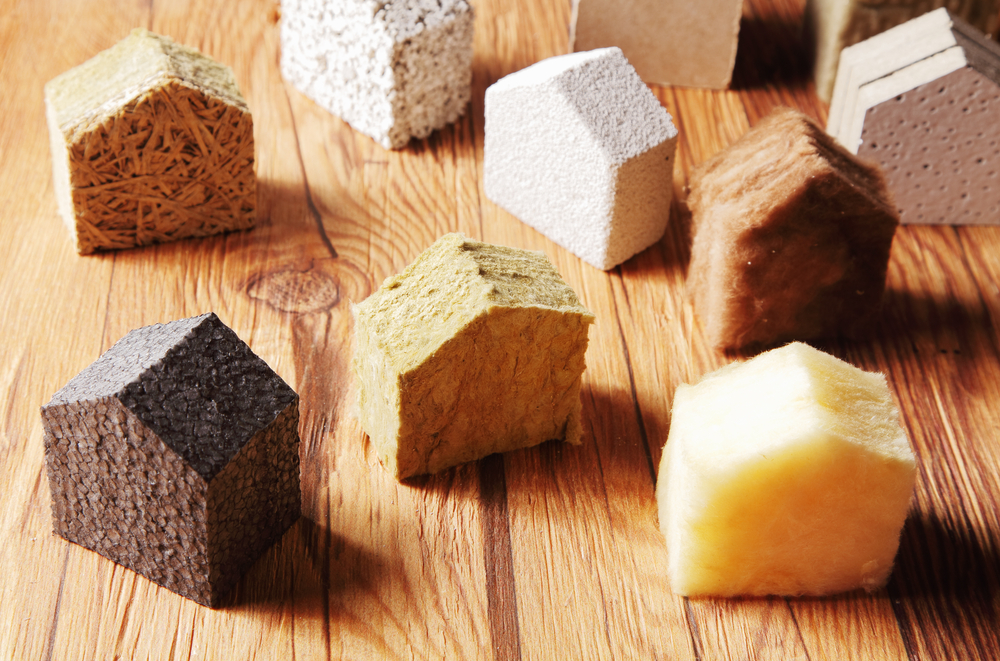Polystyrene Insulation Board
(20 Products)Polystyrene insulation is a synthetic polymer derived from the monomer styrene, a petroleum-based product. It comes in two main forms: Expanded Polystyrene (EPS) and Extruded Polystyrene (XPS). While both types offer insulating properties, there are notable differences.
EPS provides basic thermal properties, making it more suited for less demanding applications. On the other hand, XPS delivers superior insulation capabilities, making it the preferred choice for applications requiring superior thermal efficiency.
Both forms contribute to energy conservation by reducing heat transfer, helping make buildings more energy-efficient and comfortable year-round.
What Is Polystyrene Insulation?
Polystyrene insulation, while commonly used, has limitations in its insulating properties compared to some other materials. It is primarily available in two forms: expanded polystyrene (EPS) and extruded polystyrene (XPS).
EPS is lightweight and cost-effective, but its insulating capabilities are modest compared to other materials. It's often used in situations where moderate insulation is acceptable, such as in packaging or construction applications where cost is a primary concern.
XPS, on the other hand, offers slightly better insulation performance than EPS due to its denser, closed-cell structure. However, it still falls short of the thermal performance provided by materials like rigid foam boards or spray foam insulation.
Both EPS and XPS are relatively easy to work with and provide some degree of thermal resistance. However, it's essential to consider their limitations when selecting insulation materials for a project. In applications where high levels of insulation are required, such as in energy-efficient construction or in extreme climates, alternative insulation materials may be more suitable.
Where Can You Use Polystyrene Insulation?
- Wall Systems: Both external and internal walls can be insulated with polystyrene to reduce heat transfer.
- Flooring: Polystyrene insulation boards are often laid below floor surfaces to provide thermal comfort and reduce heat loss.
- Roofing: Suitable for both flat and pitched roofs, these insulation boards can be applied directly beneath the roof covering.
- Basements and Foundations: Their resistance to moisture makes them ideal for insulating basements and crawl spaces.
Types of Polystyrene Insulation
Polystyrene foam insulation comes in two main varieties:
- Expanded Polystyrene (EPS): This type is lighter and is often used for wall insulation, floor slabs, and foundation systems.
- Extruded Polystyrene (XPS): Denser and more water-resistant than EPS, XPS is often chosen for roofing and for insulating areas that might come in contact with moisture.
To greater understand the difference between both of these materials, take a look at our comprehensive blog on the Differences Between XPS and EPS.
Expanded Polystyrene Insulation
When compared to other rigid insulations, Expanded Polystyrene Insulation Board (otherwise known as EPS) is, without doubt, the most cost-effective. This is due to the fact that it is less dense and cheaper than XPS as it is less thermally effective.
Unlike XPS, EPS is not a closed-cell insulation board (whilst it has a closed-cell structure) meaning it allows water vapour/moisture to penetrate over time.
Despite its performative inferiority to more premium brands of thermal insulation, EPS exhibits consistent thermal performance in an extensive range of building insulation applications such as floor, wall and loft applications.
Not only do they possess high load-bearing capacity but they are also moisture resistant and unaffected by bacteria, moulds and fungi.
EPS insulation is predominantly used as floor insulation and in external wall insulation systems. Most people invest in Jablite insulation boards when they want to reduce the amount of heat they lose through their floorboards or floor tiles.
EPS insulation is available in a range of thicknesses from 25mm to 100mm, which makes it suitable for a range of insulation projects.
Extruded Polystyrene Insulation
Extruded polystyrene insulation (often referred to as XPS) is manufactured, as the name would suggest, through an extrusion process. Kingspan is the main manufacturer of this insulation in the UK. Extruded polystyrene insulation (XPS) is manufactured using a process of extrusion.
This process results in a closed-cell structure that boasts smooth, dense skin on both faces. The closed-cell structure of extruded polystyrene (XPS) prevents water penetration, thus providing long-term strength and durability.
Kingspan GreenGuard boards have a thermal conductivity of 0.034 W/mK. As such, XPS foam is marginally more effective than EPS foam as a thermal insulator.
It is tough when it comes to insulation yet gentle when it comes to the environment, as the blowing agent used to manufacture it has zero ODP (Ozone Depletion Potential) and low global warming impact.
GreenGuard insulation is high-performing in its versatility and can be installed in both residential and commercial properties. You can install Kingspan GreenGuard XPS foam in inverted roofs, basements, car parks, and even underneath industrial cold-flooring.
GreenGuard foam boards have a compressive strength of 300 kPa, meaning these boards will not lose their thermal properties when placed under pressure.
We stock a wide range of extruded polystyrene insulation thicknesses from 30mm to 120mm.
How to Cut Polystyrene Insulation Boards
- Prepare Your Workspace: Ensure you have a flat surface to work on and wear safety glasses.
- Measure and Mark: Use a straight edge and a marker to outline your desired measurements on the insulation board.
- Use a Sharp Knife: A utility knife or a hot wire cutter can be used. If using a knife, ensure it's sharp for cleaner cuts.
- Score and Snap: Gently score the board along the marked lines and then apply gentle pressure to snap it.
- Smooth Edges: Sand any rough edges for a clean finish.
Frequently Asked Polystyrene Insulation Questions
Is Polystyrene Insulation a Good Insulator?
Polystyrene boards have a thermal conductivity value between 0.034 and 0.038 W/mK. XPS foam boards are more efficient thermal insulators than EPS insulation boards.
Polystyrene does not deliver the best thermal conductivity values on the market. Phenolic insulation has a thermal value of 0.018 W/mK, which makes it the most efficient material available for thermal protection. Polystyrene is more suited to applications where thermal values are less of a consideration, but where compressive strength is important.
Are Polystyrene Insulation Boards Good For Compressive Strength?
Kingspan GreenGuard boards have a compressive strength of 300 kPa, whereas EPS70 jablite polystyrene boards have a compressive strength of 70 kPa.
The higher the compressive strength, the longer the material maintains its properties. GreenGuard boards perform well when they are installed in heavy roof structures and underneath heavy floors. Lots of commercial property owners invest in polystyrene foam because it maintains its thermal properties despite heavy footfall.
What Does the Number in the Title of Each Expanded Polystyrene Board Indicate?
The number signifies the compressive strength. For instance, EPS70 has a compressive performance of 70 Kilopascal (kPa).
Why Is Compressive Strength Important When Selecting Polystyrene Foam Insulation?
Compressive strength is vital as it determines the load resistance of the material. A higher compressive strength means the insulation can withstand more external pressure.
Will Footfall and Vibrations Affect the Durability of EPS Boards?
High compressive strength ensures that external pressures like footfall and vibrations don't compromise the longevity of EPS boards.
Do XPS Foam Boards Also Have Numbers in Their Titles? What Do They Indicate?
Yes, like EPS, XPS foam boards have numbers. For example, all XPS products in our range have a compressive strength of 300kPa, indicating they can withstand greater pressure.
Which Is More Suitable for Commercial Spaces: EPS or XPS?
XPS is more recommended for commercial spaces due to its higher compressive strength, making it ideal for insulating heavy floors and roofs.
Are Polystyrene Insulation Boards Sustainable?
Unlike XPS, EPS can be constructed with recycled content, making it the more environmentally friendly option of the two.
However, this sustainability does not come without its disadvantages. The voids between the polystyrene beads of EPS also make it more permeable and susceptible to water absorption. And with the absorption of water, comes the dreaded decrease of R-Value (dulling down its already quite low thermal properties).
Resisting water is critical for high-performance insulation due to the fact that water is an excellent conductor of energy.
Water ingress will ultimately hurt the overall thermal effectiveness of the board since water allows energy to short circuit or bypass its way through the board’s structure; reducing the overall effectiveness of thermal performance.
It should be noted then, that EPS’ potential to absorb water is 10 times greater than XPS, which does not absorb water at all, due to its closed-cell structure. This enables it to maintain insulating power in the presence of water.


.jpg)








